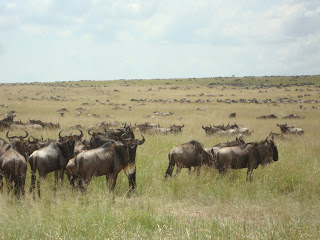It's official - the annual migration of the wildebeest from the Serengeti in Tanzania to the Masai Mara in Kenya started six days ago. The comical animals nicknamed "the clown of the plains" and said to be put together by a committee, have moved across the south Mara plains. The herds split before entering the Central Plains with one herd heading west and the other to the north.
It’s a welcome surprise to see the migration start earlier than expected. Also this time, the main migration for the south arrived before the Loita herds as has been the tradition.
GREAT MIGRATION OF WILDEBEEST AND ZEBRAS
Having crossed the Sand River, the wildebeest with the zebras mowed their way from Keekorok to the Mara Bridge covering a distance of about 25 to 30 kilometers in a few days. Marching north towards Lookout Hill, they are busy and noisy as this is their rutting season. The males are calling, running up and down and fighting any competition to win over the females. It is indeed an interesting time to be in the Mara.
The females with their five-month-old calves are relishing the fresh red oat grass. However many natural water holes in the Mara are dry which will hasten the wildebeest to move further in search of waterholes with water in them. The first destination will be Ol-keju- Ronkai River and the Mara River near the Mara Intrepids Camp. This might mean that the Mara River crossing may happen sooner than expected.
Due to the recent heavy rains, there’s a lot of grass for the herbivores. The effect? It’s triggered the mating season for elephants and topis. We are seeing many herds of elephants around Olkiombo.
The topis are in their local breeding grounds on Topi Plains and Paradise Plains. There’s good game viewing east of Mara Intrepids towards the Masai villages where the grass is short due to over grazing by the Masai cattle.
Down south towards Lookout Hill, there are a lot of zebras and topis.
Predator Sightings
Lions
Lion sightings are still good but the prides are beginning to split into small group. This is primarily due to the availability of prey because the grass-eating prey or the herbivores are moving to the short grass plains.
The Olkiombo Pride has split into four groups – there’s a lioness with her cubs who is avoiding all male lions because the males may take the food for the family.
Since April, the four sub adult males are down to three. This is because one of the males has left the pride after attacking a herd of Masai cattle. This male is still within its home range.
The three adult males are moving towards Maji-ya-Fisi pride (Hyena Dam) hoping to take over that pride if they do not encounter any resistance from the males.
The Paradise Pride is strong; it has six adult males who hunt hippos. This provides the pride with enough food.
The Ol-Kejuronkai Pride still has two males. Altogether, it has thirteen members in the family pride. They are well fed and looking healthy. This is one area that the herbivores avoid because the grass is one and half meter high making it difficult for them to see the predator approaching. This pride preys on the old, solitary buffaloes.
Leopards
Leopards have been seen around Olkiombo, along the Talek and Olare-Orok Rivers.
Olive, one of the BBC Big Cat Diary film stars, has been prowling between Mara Explorer and Mara Intrepids. She is with her two twelve-month old male cubs who are left alone most the time for one or two weeks during which time they try to hunt hares and Kirk’s dik-dik. Olive has been hunting warthog piglets, impalas and Bohor reedbucks. The Ridge male who is the father of Olive’s male cubs is between Olare Orok and Rhino Ridge.
Big Boy who is the father of Olive’s three sub adult cubs - Aya, Binti and Kali - is between Talek and Mara River. He has been sharing territory with his son, Kali.
North of Mara Intrepids along Intiakitiak River, a female that has been there for some time has finally brought her two cubs out of the hidden lair. They are five months old and we are yet to name them.
Cheetahs
For the last seven months a female cheetah with a cub named Saba has been seen at Topi Plains where there is a lot of plains game. The cub is eight months old and is being trained by her mother to hunt young Tommies.
The three cheetah brothers are residing on top of Rhino Ridge hunting warthogs. However the topis are proving too hard for them.
You can read more on Mara Intrepids at http://www.heritage-eastafrica.com/tented-camps/mara-intrepids/
Book and pay for two nights at this property and get the third free! http://www.heritage-eastafrica.com/specials/3-for-2-safari-special/
John Parmasau, Safari Guide, Mara Intrepids
(Lo'mon is Samburu for news; Le Heritage means from Heritage)
(Lo'mon is Samburu for news; Le Heritage means from Heritage)






